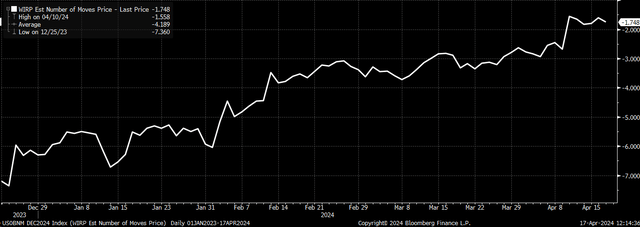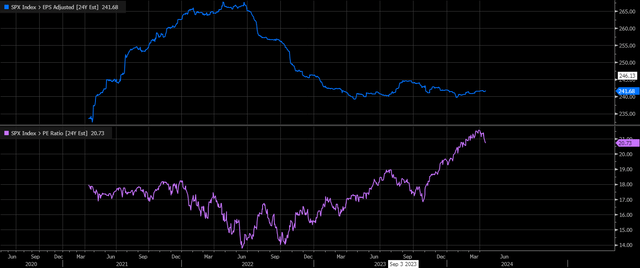

Paul Souders/DigitalVision via Getty Images
The S&P 500 has pulled back about 4.6% from its recent highs, which is nothing to cause great concern. However, the declines thus far have been due to the market’s changing expectations around the path of monetary policy, not the geopolitical tension many media outlets and market pundits have pointed to. The evidence is within the market and is critical to understand because it may determine where it is heading.
In this case, geopolitical tensions are the easy and obvious headline explaining the recent stock pullback. But that’s not really what’s happening when digging deeper because rates, the dollar, the yen, and oil do not reflect the typical flight to safety trades one would expect.
No Flight To Safety
In most flight-to-safety situations, the obvious observations are bond yields going lower, the dollar strengthening against most major currencies, the yen strengthening vs. the dollar, and, with rising Middle East tensions, surging oil.
Since the hotter-than-expected CPI report, the 10-year rate has soared, and it hasn’t come down, instead rising to about 4.61% from its closing rate of 4.36% on March 9. Yes, the dollar has strengthened, but the yen has weakened from 151.70 to around 154.40. Meanwhile, oil prices have been declining. You’re just not seeing the typical flight-to-safety trades happening.
Financial Conditions Are Tightening
What you’re seeing are credit spreads widening, coupled with higher rates, and creating tighter financial conditions, and that’s in response to a Fed monetary policy that’s going to continue to be higher for longer because inflation, as Jay Powell noted on April 16, has stalled out, which means the Fed no longer has the confidence it needs to cut rates “soon.” That now has the market pricing in fewer than two rate cuts in 2024 and now sees the first rate coming in November.

Bloomberg
Tighter financial conditions make this pullback different from what has been witnessed since the October lows when financial conditions started to ease. The market is correcting its errors, and now the Fed is back peddling rate cuts for 2024. That means the declines in equities we have seen are closer to the beginning than the end because financial conditions still need to tighten considerably further to transmit policy that will start to cool the economy and bring down inflation.
A Fantasy

Bloomberg
The equity market rally was driven by easing financial conditions and multiple expansion, not because the outlook for earnings was improving, but because earnings estimates for 2024 haven’t changed since the fall of 2022. As financial conditions tighten, the PE ratio of the S&P 500 will contract, and the gains will be given back.
You may be very disappointed if you’re betting that this is some normal pullback in a bull market. What’s happening is that the market made a mistake, and now it will need to correct that mistake.
Join Reading The Markets Risk-Free With A Two-Week Trial!
(*The Free Trial offer is not available in the App Store)
Reading the Markets helps readers cut through all the noise, delivering daily video and written market commentaries to prepare you for upcoming events.
We use a repeated and detailed process of watching the fundamental trends, technical charts, and options trading data. The process helps isolate and determine where a stock, sector, or market may be heading over various time frames.




